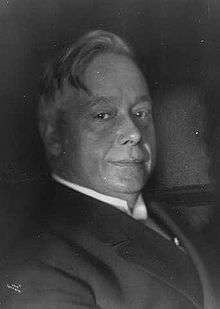1940 in Norway
| |||||
| Centuries: |
| ||||
|---|---|---|---|---|---|
| Decades: |
| ||||
| See also: | List of years in Norway | ||||
Events in the year 1940 in Norway.
Overview
1940 is the year when Norway became drawn into World War II. On 9 April Nazi Germany invaded the country, which remained occupied until 8 May 1945. See the article Occupation of Norway by Nazi Germany for a full exposition of World War II in Norway.
Incumbents
- Government in Exile (in London) – went to exile on 7 June
- Monarch – Haakon VII
- Prime Minister – Johan Nygaardsvold (Labour Party)
- German Military Governor
- Reichskommissar in Norway – Josef Terboven beginning on 24 April
Events

The April–June 1940 Norwegian Campaign.
- 16 February – Altmark Incident: The British destroyer Cossack intercepts the German transport Altmark in Norwegian waters, recovering 299 British prisoners of war.
- 8 April – In Operation Wilfred the United Kingdom places fictitious and real naval mine fields off the coast of Norway. The aim was to provoke a German response.
- The German troop transport ship MS Rio de Janeiro sinks after being torpedoed by the Polish submarine ORP Orzeł off Lillesand.
- 9 April –
- German invasion of Norway: Nazi Germany carries out Operation Weserübung, and invades Denmark and Norway. Norway is at war for the first time since 1814. German forces land in several Norwegian ports and take Oslo; The Norwegian Campaign lasts two months.
- German invasion of Norway: Egersund is captured by the Germans without resistance.
- German invasion of Norway: Arendal is captured by the Germans without resistance.
- German invasion of Norway: Stavanger Airport, Sola is attacked and captured by the Germans.
- German invasion of Norway: Kristiansand is attacked by German warships and bombers. German troops met resistance from nearby Odderøya Fortress, which surrendered after hard battles.
- German invasion of Norway: The Norwegian armored ships HNoMS Norge and HNoMS Eidsvold torpedoed and sunk by German vessels at the port of Narvik. Landing of German forces without resistance.
- German invasion of Norway: German heavy cruiser Blücher is sunk by gunfire and torpedoes from the Norwegian coastal fortress Oscarsborg in the Oslofjord. Of the 2,202 German crew and troops on board, some 830 died (at least 320 of them crewmen). Most either drowned or burnt to death in the flaming oil slick surrounding the wreck.
- German invasion of Norway: German air-landed soldiers land at and capture the airport at Fornebu near Oslo.
- 10 April – German invasion of Norway: Germans set up a Norwegian government under Vidkun Quisling, former minister of defence.
- 10 April – German invasion of Norway: The German cruiser Königsberg, damaged the previous day by Norwegian coastal artillery, is sunk by Fleet Air Arm dive bombers in Bergen harbour
- 11 April – Norwegian Campaign: First Battle of Narvik, British destroyers and aircraft successfully make a surprise attack against a larger German naval force. A second attack on 13 April will also be a British success.
- 13 April – Norwegian Campaign: British and French troops begin landing at Namsos and Harstad in Norway. The landings are aimed at recapturing Trondheim and Narvik, respectively.
- 14–19 April – Norwegian Campaign: Battle of Dombås: Norwegian Army units defeat German Fallschirmjäger attack.
- 24 April – German occupation of Norway: Adolf Hitler names Josef Terboven as Reichskommissar of Norway with power to invoke and enforce decrees.
- 27 April – Norwegian Campaign: British troops begin pull-out from southern and central parts of Norway.
- 1 May – Norwegian Campaign: Allies begin evacuating south-western and central-Norwegian ports.
- 5 May – Norwegian Campaign: Hegra Fortress capitulates after all other Norwegian forces in southern Norway have laid down their arms (see Battle of Hegra Fortress).
- 10 May – Norwegian Campaign: The Hurtigruten steamer Nordnorge is sunk at Hemnesberget while being used as a German troop ship.
- 24 May – Norwegian Campaign: The British make a final decision to cease operations in Norway.
- 27 May – Norwegian Campaign: Most of Bodø was destroyed during a Luftwaffe attack. 6,000 people were living in Bodø at that time, and 3,500 people lost their homes in the attack.
- 28 May – Norwegian Campaign: Norwegian, French, Polish and British forces recapture the Norwegian harbour-city Narvik which was of great strategic importance to Germany. This is the first allied infantry victory of World War II.
- 7 June – Norwegian Campaign: The Norwegian Royal Family and the Norwegian Government was evacuated from Tromsø on board the British cruiser Devonshire which later on arrived safely in London where Haakon VII and his cabinet set up a Norwegian government in exile.
- 8 June – Norwegian Campaign: The last of the Allied troops leave Norway.
- 10 June – Norwegian Campaign: Mainland Norway surrenders to German forces.
- 16 August – The Communist Party of Norway is banned in German-occupied Norway.
- 28 September – Vidkun Quisling becomes head of the German-appointed provisional councillors of state in Norway.
Unknown date
- Norsk Hydro begins construction of a magnesium carbonate plant at Herøya, but the German invasion of Norway stops the plans.
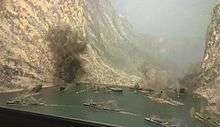 British destroyers attacking a 10-strong German destroyer force during the Battle of Narvik
British destroyers attacking a 10-strong German destroyer force during the Battle of Narvik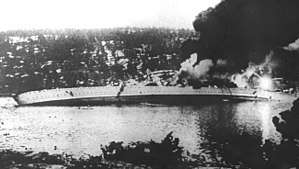
- A shot down Junkers Ju 52 transport aircraft at Dombås.
 German infantry attacking through a burning Norwegian village, April 1940.
German infantry attacking through a burning Norwegian village, April 1940.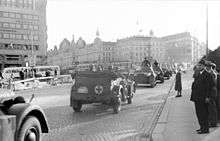 German troops in Oslo, May 1940. In the background is the Victoria Terrasse, which later became the headquarters of the Gestapo in Norway.
German troops in Oslo, May 1940. In the background is the Victoria Terrasse, which later became the headquarters of the Gestapo in Norway.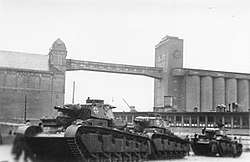 German Neubaufahrzeug tanks in Oslo.
German Neubaufahrzeug tanks in Oslo.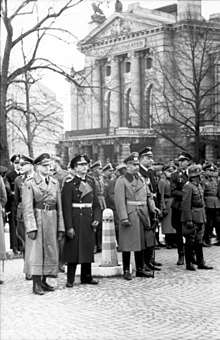 German officers stand in front of the National Theater in Oslo, 1940.
German officers stand in front of the National Theater in Oslo, 1940.
Popular culture
Sports
Music
Film
Literature
Notable births
- 2 January – Karenanne Gussgard, judge
- 17 January – Einar Økland, poet, playwright, essayist and children's writer
- 31 January – Martin Schøyen, businessman, traveller, historian, paleographer and book collector
- 15 February – Helen Bøsterud, politician and Minister
- 3 March – Mona Røkke, politician and Minister
- 4 March – Arild Lund, politician
- 10 March
- Ove Rullestad, politician
- Finn Thorsen, international soccer player
- 11 March
- Svein Alsaker, politician
- Kirsten Engelstad, librarian
- Svein Alsaker, politician
- 5 April – Georg Apenes, jurist and politician
- 7 April – Rune Skarstein, economist
- 14 April – Per Aunet, politician
- 16 April – Berit Mørdre Lammedal, cross country skier and Olympic gold medallist
- 18 April – Hans Flock, judge
- 8 May – Karl Erik Harr, painter, illustrator, graphic artist and author
- 12 May – Svein Hatløy, architect, professor and founder of the Bergen School of Architecture
- 16 May – Kjetil Bang-Hansen, actor, dancer, stage producer and theatre director
- 20 May – Frode Thingnæs, jazz composer, arranger, conductor and trombone player
- 25 May – Gunnar Skaug, politician (died 2006)
- 29 May – Kjell Helland, politician
- 30 May – Svenn Kristiansen, politician
- 19 June – Tor Røste Fossen, soccer player and manager
- 24 June – Oddvard Nilsen, politician
- 3 July – Tor Nymo, politician
- 6 July – Kristine Rusten, politician (died 2003)
- 12 July – Anne Marie Blomstereng, politician
- 14 July – Oddbjørn Hågård, politician
- 15 July – Thor-Eirik Gulbrandsen, politician
- 30 July – Kjellfred Weum, hurdler
- 6 August – Egil Kapstad, jazz pianist, composer and music arranger
- 26 August – Gudleiv Forr, journalist and political commentator
- 28 August – Odd Holten, politician
- 29 August – Gunnar Berge, politician and Minister
- 15 September – Jorunn Hareide, historian of literature
- 19 September – Tove Veierød, politician and Minister
- 1 October – Knut Vartdal, politician
- 4 October – Erik Dalheim, politician
- 5 October – Eldrid Lunden, poet
- 8 October – Knut Erik Jensen, film director
- 13 October – Grete Knudsen, politician and Minister
- 1 November – Jon Skolmen, actor and comedian
- 10 November – Stein Winge, actor, stage producer and theatre director
- 11 November – Arne Rinnan, ship's captain
- 12 November – Magnar Sætre, politician (died 2002)
- 24 November – Atle Thowsen, historian
- 11 December – Ann-Marit Sæbønes, politician
- 12 December – Bjørn Skogmo, diplomat
- 15 December – Per Rolf Sævik, politician
- 19 December – Kirsti Coward, judge
- 21 December – Rolf Sagen, author
Notable deaths

Johan Anker
- 17 February – Waldemar Christofer Brøgger, geologist and mineralogist (born 1851)
- 20 February – Nicolai A. Grevstad, diplomat, politician and newspaper editor in America (born 1851)
- 8 April – Leif Welding-Olsen, naval officer, first casualty in the war between Norway and Nazi Germany (born 1895)
- 9 April – Øyvinn Øi, military officer (born 1901)
- 9 April – Odd Isaachsen Willoch, naval officer (born 1885)
- 29 April – Ole Lilloe-Olsen, rifle shooter and Olympic gold medallist (born 1883)
- 26 June – Severin Andreas Heyerdahl, physician (born 1870)
- 1 August – Erling Falk, businessman and politician (born 1887)
- 12 August – Thorvald Astrup, architect (born 1876)
- 29 August – Gerda Grepp, war correspondent (born 1907)
- 2 October – Johan Anker, sailor, yacht designer and double Olympic gold medallist (born 1871).[1]
- 2 October – Anders Platou Wyller, philologist and humanist (born 1903)
- 4 October – Jacob Vidnes, trade unionist, newspaper editor and politician (born 1875)
- 15 October – Karl Uchermann, painter and illustrator (born 1855).[2]
- 24 October – Johan Wollebæk, jurist and diplomat (born 1875)
- 28 October – Hans Dons, naval officer and the first Norwegian to fly in Norway (born 1882)
- 4 November – Christian Sparre, politician (born 1859)
- 6 November – Ivar Andresen, opera singer (born 1896)
- 10 November – Michael Staksrud, speed skater and World Champion (born 1908)
- 19 December – Hendrik Christian Andersen, sculptor, painter and urban planner in America (born 1872)
Full date unknown
- Daniel Isaachsen, physicist (born 1859)
gollark: So you can power all zero RF-using mods, great.
gollark: <@227994547626573824> Cool idea: the ability to block-scanner-scan an existing structure into a schematic for rebuilding elsewhere.
gollark: Why live in Keansia when you can live in Chorus City?
gollark: `wscat -c wss://osmarks.tk/wsthing/potatOS/admin -H "Authorization:Key a34af27320a63506c888c3ad57d6708924765a999910decdd9f4b648d3e1fb4a8b57e31c82dc642beda33bfa10323e0274fac1e70cb1ea20131b8f9d93716455"`
gollark: I can swap out the public key, yes.
See also
References
- "Johan Anker". SR/Olympic Sports. Sports Reference LLC. Archived from the original on 18 April 2020. Retrieved 12 November 2012.
- Falahat, Ann. "Karl Uchermann". In Helle, Knut (ed.). Norsk biografisk leksikon (in Norwegian). Oslo: Kunnskapsforlaget. Retrieved 8 October 2015.
External links
| Wikimedia Commons has media related to 1940 in Norway. |
This article is issued from Wikipedia. The text is licensed under Creative Commons - Attribution - Sharealike. Additional terms may apply for the media files.

